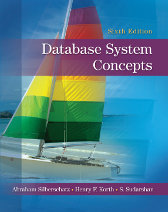What's New in the 6th Edition?
- New running example of a university database:
- More intuitive and motivating for students.
- Illustrates more complex design tradeoffs in the database-design chapters.
- All example tables collected in an appendix in the text and available online.
- Larger database based on example schema available online for projects and assignments.
- All chapters have been revised to reflect the latest advances in technology.
- Chapter 2 (Relational Model) gives brief introduction to relational algebra. Technical details of the relational algebra and relational calculus are postponed to Chapter 6. Instructors may omit these topics if desired. Chapter 6 can be moved ahead and covered immediately after Chapter 2 for instructors preferring a more traditional sequence.
- Chapters 3 -- 5: Revised coverage of SQL
- Greater attention to variants of SQL in actual systems.
- More detail on SQL features.
- Puts SQL first:
- All SQL features covered in the book, including OLAP constructs, JDBC, views, and authorization are included in these chapters.
- Allows for SQL projects earlier in the semester, leaving time later in the semester for database design/application development.
- Chapter 7: ER Model
- Revised ER notation more compatible with UML.
- Chapter 8: Relational Design
- Updated intuitive coverage of normalization motivates subsequent coverage of functional dependency theory.
- Examples illustrating real world issues in database design.
- Chapter 9: Application Design and Development
- Expanded and updated coverage of Web-based application development, including MVC architectures, and Object-Relational Mapping (Hibernate). Brief coverage of JavaScript and PHP.
- Expanded coverage of security including practical issues in application security.
- Chapters 10-13: Storage, Indexing, Query Processing and Optimization
- Expanded coverage overall.
- Flash storage systems covered in more detail.
- B+-tree examples now use n=4, avoiding special case of empty nodes.
- Bulk loading of B+-trees.
- New material on advanced optimization techniques.
- Chapter 14-16: Revised coverage of transaction management
- Expanded coverage of basics in Chapter 14, providing sufficient coverage of transactions, including both recovery and concurrency, for many introductory courses.
- Chapters 15 and 16 provide detailed coverage of concurrency and recovery:
- Newly expanded, detailed coverage of snapshot isolation (a concurrency control technique that is widely supported and used in current database products.)
- Revised and simplified coverage of recovery, with a single algorithm for physical logging that is then extended to allow logical logging, followed by ARIES. Several new examples to illustrate concepts.
- Chapter 17-19: Database Architectures, Parallel and Distributed Databases
- Chapter 17 provides a broad overview of parallelism and distribution. Chapters 18 and 19 provide updated coverage that includes recent developments, including:
- Database processing on multicore processors.
- Cloud-based data storage systems.
- Discussion of consistency versus availability (ACID vs BASE).
- Chapters 20-21: Data Warehousing, Data Mining and Information Retrieval
- New material on support vector machines, and validation of classifiers.
- Information retrieval beyond ranking of pages: diversity, entities and concepts
- Chapters 22-23: Object-Based Databases and XML
- Moved back to later in the book, since these topics are typically covered only in advanced courses.
- Updated Web site (db-book.com)
- New material for laboratory exercises.
- Online appendices, slides for all chapters.
- Solutions for exercises.
Last updated November 2009.
 Database System Concepts
Database System Concepts